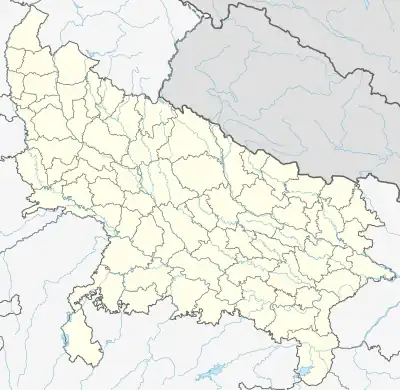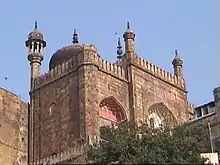| Alamgir Mosque, Varanasi Aurangzeb's Mosque | |
|---|---|
 | |
| Religion | |
| Affiliation | Islam |
| Ecclesiastical or organizational status | Functional |
| Location | |
| Location | Varanasi, India |
| State | Uttar Pradesh |
 Location in Uttar Pradesh, India | |
| Geographic coordinates | 25°18′55″N 83°01′04″E / 25.31534°N 83.01781°E |
| Architecture | |
| Founder | Aurangzeb |
The Alamgir Mosque or Aurangzeb's Mosque is a mosque in Varanasi, Uttar Pradesh, India.[1][2]
Location
The mosque is located at a prominent site above the Panchaganga Ghat. The ghat has broad steps that go down to the Ganges.[3]
Aurangzeb conquered Varanasi in 1669 and built a magnificent mosque destroying Bindu Madhav Temple[2][4][5] and named it as Alamagir Mosque in the name of his own honoury title "Alamgir", which he had adopted after becoming the emperor of the Mughal empire.[4]
The minarets couldn't withstand the test of time and in the 19th century, an English scholar James Prinsep had to restore them. In 1948 one of the minarets collapsed killing a few people around the time of the floods. Later the government pulled down the other minaret due to security reasons.[6][7]
Features

The mosque is architecturally a blend of Islamic and Hindu architecture.[6] The mosque has high domes and minarets.[8][7] Two of its minarets were damaged; one minaret collapsed killing a few people and the other was officially brought down owing to stability concerns.[7] The Panchaganga Ghat where the mosque is situated is where five streams are said to join. In October lamps are lighted on top of a bamboo staff as a mark of guidance to the ancestors.[8]

References
Citations
- ↑ Crowther, Raj & Wheeler 1984.
- 1 2 "Alamgir Mosque – Lost Vishnu Temple Of Varanasi". Varanasi Guru. 6 April 2018. Retrieved 6 April 2018.
- ↑ Hussain 1999, p. 70.
- 1 2 Davenport Adams, W. H. (1888). India Pictorial and Descriptive. T. Nelson and Sons. p. 138.
- ↑ Dunlop, Sykes & Jackson 2001, p. 135.
- 1 2 Kumar 2003, p. 90.
- 1 2 3 Betts & McCulloch 2013, p. 213.
- 1 2 Shetty 2014, p. 73.
Bibliography
- Betts, Vanessa; McCulloch, Victoria (27 September 2013). India – The North: Forts, Palaces, the Himalaya Dream Trip. Footprint Travel Guides. ISBN 978-1-907263-74-3.
- Crowther, Geoff; Raj, Prakash A.; Wheeler, Tony (1984). India, a Travel Survival Kit. Lonely Planet.
- Dunlop, Fiona; Sykes, Carol; Jackson, Felicity (2001). Fodor's Exploring India. Fodor's Travel Publications. ISBN 978-0-679-00707-4.
- Hussain, Ansar (1 January 1999). Rediscovery of India, The: A New Subcontinent. Orient Blackswan. ISBN 978-81-250-1595-6.
- Kumar, Brajesh (2003). Pilgrimage Centres of India. Diamond Pocket Books (P) Ltd. ISBN 978-81-7182-185-3.
- Shetty, Rekha (1 May 2014). Innovation Sutra: The Secret of Good Business and a Good Life. Penguin Books Limited. ISBN 978-93-5118-696-0.
Further reading
- Vit-Suzan, Dr Ilan (28 March 2014). Architectural Heritage Revisited: A Holistic Engagement of its Tangible and Intangible Constituents. Ashgate Publishing, Ltd. ISBN 978-1-4724-2064-0.
